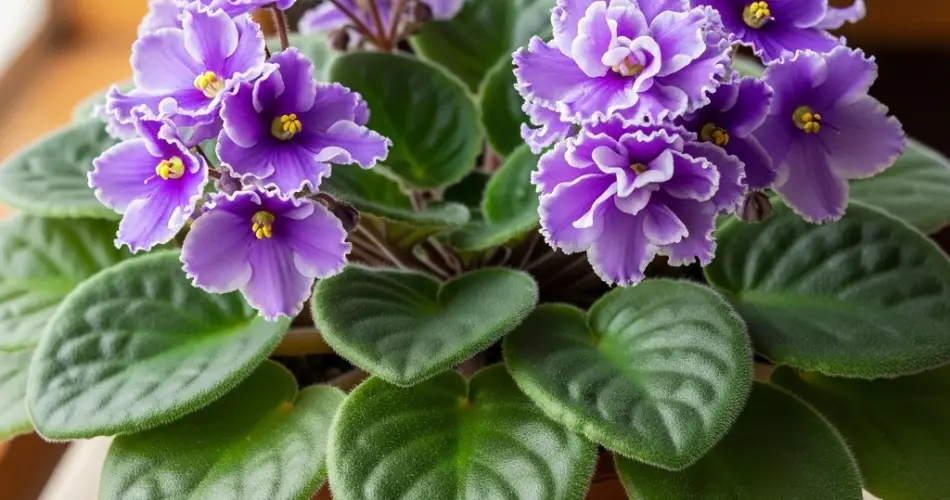African violets (Saintpaulia species) are among the most beloved houseplants, cherished for their compact rosettes, fuzzy leaves, and vibrant, long-lasting blooms. Their ability to flourish indoors makes them perfect for windowsill gardens, adding bursts of color and life to small spaces. With the right care techniques, these charming plants can transform any windowsill into a thriving mini-garden.
This guide will walk you through everything you need to know to make your African violets thrive on your windowsill—from light and watering to feeding and maintenance—so you can enjoy continuous blooms and lush foliage.
Choosing the Perfect Spot
Lighting is critical for African violets. They need bright, indirect sunlight to grow strong and bloom frequently. A south- or east-facing windowsill often works best. While they can tolerate lower light levels, insufficient light can lead to leggy plants with fewer flowers.
Direct sunlight, especially during midday, can scorch their delicate leaves. If your windowsill receives harsh sun, filter it with a sheer curtain or place the plant a few inches back from the glass. For rooms with limited natural light, consider supplementing with a fluorescent or LED grow light for 12–14 hours a day.
Watering Techniques
Watering correctly is one of the most important factors for African violet success. These plants prefer soil that is evenly moist but not waterlogged, and they are particularly sensitive to water on their leaves, which can cause spotting or rot.
Bottom Watering
The best method is bottom watering:
-
Fill a shallow tray with lukewarm, filtered, or distilled water.
-
Place the pot in the tray, allowing the soil to absorb water through the drainage holes.
-
Remove the pot once the top of the soil feels moist.
This technique keeps the leaves dry and prevents common problems associated with top watering.
Soil and Drainage
Use a well-draining potting mix designed for African violets or a mix of peat, perlite, and vermiculite. Always ensure pots have drainage holes to prevent root rot, and avoid letting water sit in saucers for extended periods.
Feeding for Vibrant Blooms
African violets require regular feeding to support foliage growth and flowering.
-
Use a balanced, water-soluble fertilizer formulated for African violets, with a typical N-P-K ratio of 14-12-14.
-
Feed every 4–6 weeks during the growing season.
-
Dilute the fertilizer to half the recommended strength to avoid overfeeding, which can damage roots and leaves.
During fall and winter, reduce fertilization since plant growth slows, resuming regular feeding in spring to encourage new blooms.
Potting and Repotting
While African violets prefer to be slightly root-bound, refreshing the soil every 12–18 months promotes healthy growth and prevents soil compaction. Repot in a container slightly larger than the current one, using fresh, well-draining soil.
Be gentle with roots during repotting, as African violets are sensitive to disturbance. Trim dead or damaged leaves to encourage new growth and maintain a neat appearance.
Maintaining Healthy Leaves
Dust can accumulate on African violet leaves, reducing photosynthesis and overall vigor. Wipe leaves gently with a soft, damp cloth or use a soft brush. Avoid leaf shine sprays, which can clog leaf pores.
Brown leaf tips can indicate low humidity or chemical buildup in tap water. Increase humidity with a pebble tray or humidifier, and use filtered or distilled water to prevent tip burn.
Encouraging Continuous Blooming
To maximize blooms on your windowsill, ensure the plant receives adequate light, proper watering, and regular feeding. Remove spent flowers promptly to encourage new buds, and rotate the plant occasionally to ensure even growth on all sides.
Propagation is also easy: African violets can be grown from leaf cuttings, allowing you to expand your windowsill garden without purchasing additional plants.
Troubleshooting Common Issues
-
Yellow leaves: Often caused by overwatering or poor drainage. Adjust watering habits and ensure the soil drains well.
-
Leggy growth: Indicates insufficient light; move the plant closer to a bright window or supplement with artificial light.
-
Leaf spots: Typically a result of water on leaves or chemical damage. Avoid overhead watering and use distilled water when possible.
Final Thoughts
With proper attention to light, watering, feeding, and humidity, African violets can transform a simple windowsill into a colorful, thriving garden. Their compact size and continuous blooms make them ideal for small spaces, bringing life and beauty indoors year-round.
By mastering these care techniques, you can enjoy a flourishing African violet display that delights the eye and elevates your indoor garden experience.



